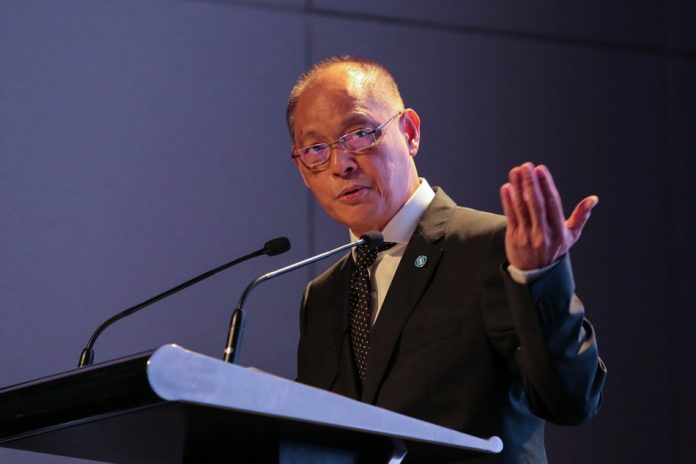
MANILA – The Philippines central bank is on course to cut its key interest rate as inflation cools, and policy easing will be on the table as soon as the May 9 meeting, governor Benjamin Diokno said.
“It’s not a matter of whether we cut, it is when,” Diokno told Bloomberg’s Kathleen Hays in Washington, where officials are gathered for the spring meetings of the World Bank and the International Monetary Fund. “We are considering it. I’m sure that will be in the agenda in the next policy meeting.”
Inflation slowed for a fifth consecutive month to 3.3 percent in March, easing into the central bank’s 2 percent to 4 percent target. Bangko Sentral ng Pilipinas left the benchmark rate unchanged at 4.75 percent at its last three meetings as it waits for inflation to be firmly entrenched in the target range.
The peso fell as much as 0.5 percent against the dollar in early trading before the Holy Week break after Diokno’s comments, halting a two-day rally. It erased the day’s losses to trade 0.1 percent higher at 51.765 at the close in Manila. Alan Cayetano, head of foreign exchange trading at Bank of the Philippine Islands, attributed the peso’s recovery to corporate dollar inflow.
The central bank is considering easing monetary policy either through a rate cut or a reduction in the reserve requirement ratio for banks, which at 18 percent remains among the highest in the region.
“It’s a question of timing, which will be first, the rates cut or the cut in the reserve ratio,” Diokno said.
Room for Easing
“Now that inflation has normalized, I think there’s a room for some easing or relaxation,” the governor said. “But we have to look at other threats,” he said, citing rising oil prices and the impact of the El Niño dry weather on food costs.
Diokno echoed some of the cautious tone of deputy governor Diwa Guinigundo, a four-decade veteran of the central bank, who said last week policy makers will ease when inflation nears the midpoint of its target band.
The 71-year-old governor, a former economics professor and budget secretary, was appointed in March to complete the unfinished term of Nestor Espenilla, who died of cancer. Diokno is perceived as pro-growth and tolerant of a weaker currency, based on his previous comments as a government minister.
When asked if he’s confident that the peso won’t come under attack when the Philippines starts easing monetary policy, Diokno said “we’re not scared of any attack because number one, our currency is based on a floating exchange rate, so it will be determined by supply and demand of currency.”
Diokno cited hefty foreign exchange reserves and robust dollar inflows from overseas Filipinos, tourism receipts and outsourcing revenue as helping to support the currency.
Behind The Curve
Bangko Sentral was criticized by some analysts last year for being slow in raising interest rates even though inflation had accelerated to a five-year high.
Diokno said in the interview that policy easing will happen at the right time. “As you know, monetary policy works with a lag, nine-month lag. If you cut rates now, it doesn’t make a difference the following day,” he said. “We will try to make it timely.”
First quarter growth “will not be as robust as we have planned” because of the 2019 budget delay, Finance secretary Carlos Dominguez said in a media roundtable
Growth may have been trimmed by 0.7 to 0.9 percentage point last quarter, Economic Planning secretary Ernesto Pernia said at the briefing. A typical 0.5 to 1 percentage point boost from election spending could help offset the slowdown, Pernia said.
The Philippines has an upcoming yuan bond sale and will tap the yen debt market in August, Dominguez said. The euro bond, “which we are turning to after many years’ of absence, we haven’t really figured out yet what the volume will be.” (Bloomberg)



